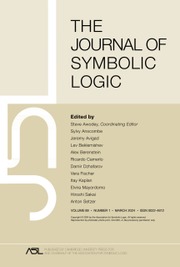Article contents
A continuous functional with noncollapsing hierarchy
Published online by Cambridge University Press: 12 March 2014
Extract
In [5] S. S. Wainer introduces a hierarchy for arbitrary type-2-functionals. Given F, he defines a set of ordinal notations OF, and for each a ∈ OF, a function fa recursive in F and an ordinal ∣a∣F <  For any f recursive in F there is an a ∈ OF such that f is primitive recursive in fa.
For any f recursive in F there is an a ∈ OF such that f is primitive recursive in fa.
Let ρF be the least ordinal α such that for any f recursive in F there is an α ∈ OF with ∣a∣F ≤ α such that f is primitive recursive in fa. If ρF <  the hierarchy breaks down. In Bergstra and Wainer [2] ρF is described as “the real ordinal of the 1-section of F”.
the hierarchy breaks down. In Bergstra and Wainer [2] ρF is described as “the real ordinal of the 1-section of F”.
Using standard methods (originally due to Kleene) one may prove that if F is normal, then ρF =  Feferman has proved that if F is recursive, then ρF = ω2.
Feferman has proved that if F is recursive, then ρF = ω2.
Let 1-section (F) = l-sc(F) = {f; f is recursive in F} where f is a total object of type 1.
Grilliot [4] proved that F ↾ 1-sc(F) is continuous if and only if F is not normal.
Let h be an associate for a given functional F, and assume that h is recursive in the jump of an element of 1-sc(F).
Information
- Type
- Research Article
- Information
- Copyright
- Copyright © Association for Symbolic Logic 1978
References
REFERENCES
- 1
- Cited by

